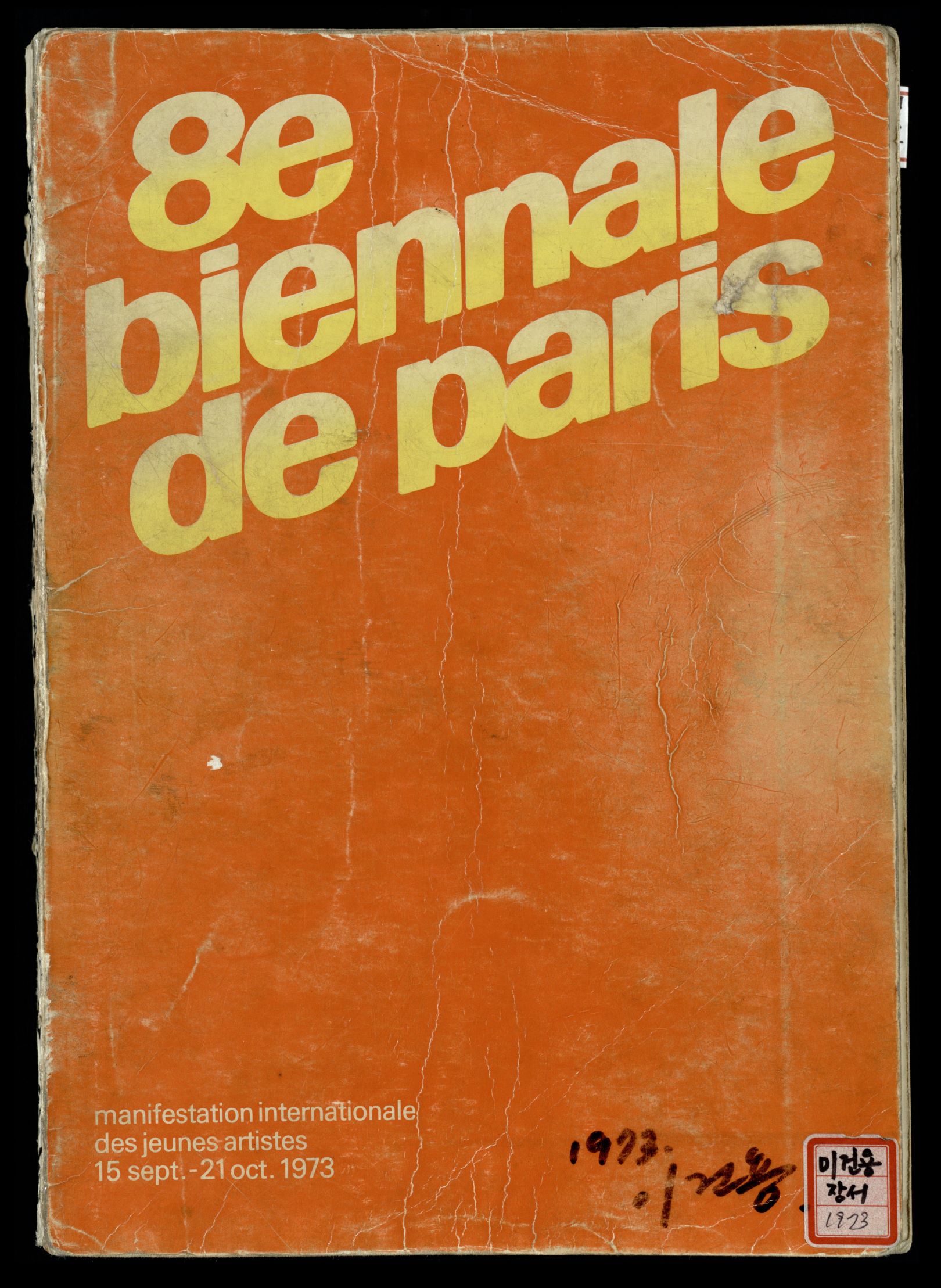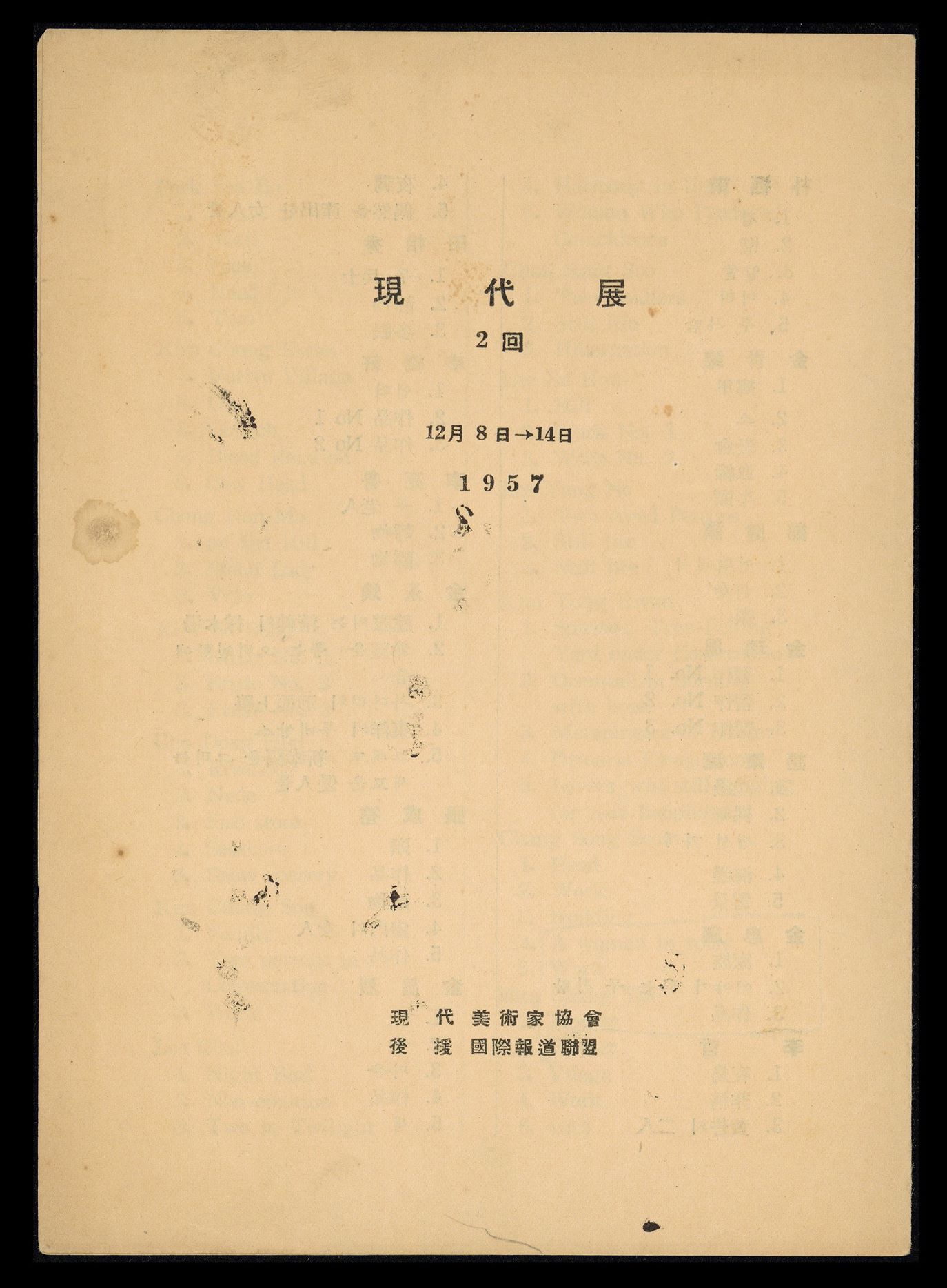
Eighth Paris Biennale, Brochure, Gift of Lee Kun-Yong, MMCA Art Research Center Collection, Gift of Lee Kun-Yong
Paris Biennale
* Source: Multilingual Glossary of Korean Art. Korea Arts Management Service
Related
-

Hyundae Fine Artists Association
An art organization formed in 1957 under the leadership of Moon Woosik, Kim Younghwan, Kim Tschang-Yeul, Jang Seong-soon, Lee Cheol, Ha Indoo, Kim Jonghwi, and Kim Cheonggwan. The association held its inaugural exhibition at the United States Information Service gallery from May 1 to 9 in 1957. As part of a new generation of artists who received university education after independence, the members chose the pursuit of the “antithesis of feudal elements that hinder the development of culture” as the task of the association, and they stated the founding purpose of the association as being to achieve “communion with the highbrow universal consciousness that is oriented toward contemporary art.” In the third exhibition, which was in 1958, the association featured Informel art, which heralded the beginning of an era of Informel in Korean art. In 1961, the association held a joint exhibition with the 1960s Artists Association, and in 1962, the two organizations merged to form Actuel.
-

Independants (1972)
Indépendants is an exhibition held by Korean Fine Arts Association [Hanguk misul hyeophoe] to solve problems of selecting artworks for international exhibitions. The first Independants exhibition was a contest held in the National Museum of Modern and Contemporary Art, Korea at Gyeongbokgung Palace from August 1 through 15 in 1972 to nominate candidates to participate in the eighth Paris Biennale and the fifth Spain Biennale. Following the principle of “no evaluation, no award” advocated by the Salon des Indépendants, which began in France in 1884, all works submitted to Indépendants were exhibited without any evaluation. Initially, the participants were limited to young artists under the age of thirty-five, with no restrictions on the content of their works. Thus, Indépendants was viewed as providing opportunities for unknown, rising artists to join international exhibitions regardless of their educational background and work experience and it inspired them to create. However, as the scope of international exhibitions expanded and the age limit of thirty-five was removed, it eventually came to “be dominated by artists of the extreme abstract art movement.” Its last exhibition was the eighth edition held in July 1980 when Park Seo-Bo, who played a leading role in organizing the Independants exhibitions, lost the election for the chairman of the Korean Fine Arts Association.
-

Sao Paulo Art Biennial
The Sao Paulo Art Biennial is an international exposition which started in 1951. The Sao Paulo Museum of Modern Art was the main venue for the event until 1957 when it moved to Ciccillo Matarazzo Pavilion. The exposition has the second longest history next to the Venice Biennale, and shares similar features with Venice, regarding the commissioner system and the use of themed exhibitions. South Korea expanded cultural exchange programs within the program since diplomatic relations were established in 1959 and began to officially participate in the Biennales after 1963. Kim Whanki, the chairman of the board of the Korean Art Association, served as the first commissioner in 1959, and seven artists including Yoo Youngkuk, Kim Youngjoo, Kim Kichang, Yoo Kangyul, Han Yongjin, Suh Seok, and Kim Whanki himself, submitted works to the exhibition. Their art pieces were previewed at the Korean Information Service Gallery in Seoul between June 14 and June 16. Over the last 70 years, Kim Bokyoung, Seo Seong-rok, Kim Youngho, Yoon Jinsup, and Oh Sang-Ghil have all been appointed as commissioners to the Biennale.
Find More
-

Venice Biennale
The Venice Biennale is an international art exhibition founded in 1895 in Venice, Italy. Its main exhibition, curated by a general director of the biennale, is held at the Arsenale, a former munitions factory, and national pavilions at Giardini Park host exhibitions curated by art directors of each participating country, making them compete against each other. South Korea first participated in the Venice Biennale in 1986 when Ko Younghoon and Ha Dongchul rented a section of the Italian Pavilion. In 1993, Paik Nam June won the Golden Lion award for his work submitted for the German Pavilion. In 1995, thanks to Paik Nam June’s efforts, the Korean Pavilion opened as the twenty-sixth national pavilion. Afterwards, Jheon Soocheon, Kang Ikjoong, and Lee Bul received a special prize at the international art exhibition of the biennale, respectively in 1995, 1997, and 1999. At the 2014 Venice Architecture Biennale, Cho Minsuk was awarded the Golden Lion for his exhibition Crow’s Eye View: The Korean Peninsula. At the art exhibition of the fifty-sixth Venice Biennale in 2015, Im Heungsoon won the Silver Lion for his documentary film Factory Complex. The Venice Biennale serves as a criterion that leads contemporary art or art market trends.
-

Kassel Documenta
Kassel Documenta is an international contemporary art event held every five years in the Kassel region located in the center of Germany. The first edition was held in 1955 at the suggestion of Arnold Bode, an artist and professor at Kassel Academy, as an event accompanying the German national garden show (Bundesgartenschau), which was held throughout Germany. In its early years, Kassel Documenta tried to promote Germany as a cultural nation by focusing on works by German artists and revisit avant-garde art that Hitler had suppressed in an effort to bring peace and stability to the country after World War II. Afterwards, artists from all around the world were allowed to participate, a judging panel of experts was formed, and a new art director was appointed each time to hold a thematic exhibition. Unlike open call biennales led by the state, Kassel Documenta is hosted by a non-profit organization and its organizing committee discovers and selects artists and works. Each edition of Kassel Documenta is characterized by the discussion of new discourses on contemporary art and the pursuit of ethnic and national diversity. Artworks are installed throughout the Kassel region with the Fridericianum and Documenta Halle as the main exhibition halls. In 1977, Paik Nam June broadcasted the Live Satellite Telecast in real time at the opening of Documenta 6, and Yook Keunbyung installed The Sound of Landscape + Eye for Field in the Fridericianum at Documenta 9 in 1992. The Kassel Documenta is a leading international art event that highlights undiscovered sites of contemporary art and presents a vision of the future.






